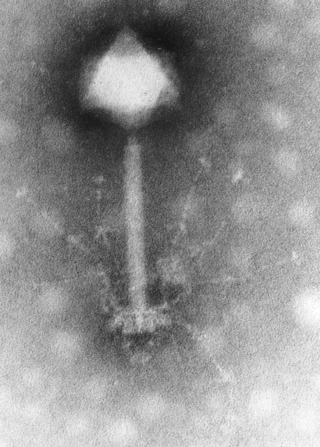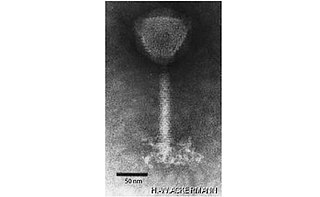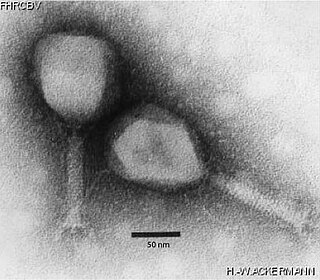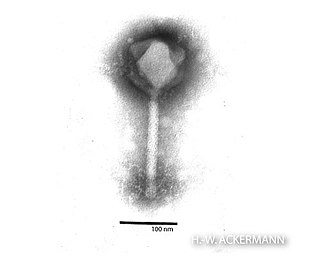
Myoviridae is a family of bacteriophages in the order Caudovirales. Bacteria and archaea serve as natural hosts. There are 625 species in this family, assigned to eight subfamilies and 217 genera.

Caudovirales is an order of viruses known as the tailed bacteriophages. Under the Baltimore classification scheme, the Caudovirales are group I viruses as they have double stranded DNA (dsDNA) genomes, which can be anywhere from 18,000 base pairs to 500,000 base pairs in length. The virus particles have a distinct shape; each virion has an icosahedral head that contains the viral genome, and is attached to a flexible tail by a connector protein. The order encompasses a wide range of viruses, many containing genes of similar nucleotide sequence and function. However, some tailed bacteriophage genomes can vary quite significantly in nucleotide sequence, even among the same genus. Due to their characteristic structure and possession of potentially homologous genes, it is believed these bacteriophages possess a common origin.
Uetakevirus is a genus of viruses in the order Caudovirales, in the family Podoviridae. Bacteria serve as natural hosts. There are three species in this genus. These phages are temperate and infect Salmonella and Escherichia coli.

Okubovirus is a genus of viruses in the order Caudovirales, in the family Herelleviridae, in the subfamily Spounavirinae. Bacteria serve as natural hosts. There are two species in this genus.
Punavirus is a genus of viruses in the order Caudovirales, in the family Myoviridae. Bacteria serve as natural hosts. There are four species in this genus.
Peduovirus is a genus of viruses in the order Caudovirales, in the family Myoviridae, in the subfamily Peduovirinae. Bacteria serve as natural hosts, with transmission achieved through passive diffusion. There are 15 species in this genus.

Schizotequatrovirus is a genus of viruses in the order Caudovirales, in the family Myoviridae, in the subfamily Tevenvirinae. Bacteria serve as natural hosts. There are three species in this genus.
Felixounavirus is a genus of viruses in the order Caudovirales, in the family Myoviridae. Bacteria serve as natural hosts, with transmission achieved through passive diffusion. There are currently 16 species in this genus, including the type species Salmonella virus FelixO1.

Tevenvirinae is a subfamily of viruses in the order Caudovirales, in the family Myoviridae. Bacteria and archaea serve as natural hosts. There are 135 species in this subfamily, most included in 12 genera.
Muvirus is a genus of viruses in the order Caudovirales, in the family Myoviridae. Bacteria serve as natural hosts, with transmission achieved through passive diffusion. There are two species in this genus.
Myohalovirus is a genus of viruses in the order Caudovirales, in the family Myoviridae. Bacteria and archaea serve as natural hosts. There are three species in this genus.

Phikzvirus is a genus of viruses in the order Caudovirales, in the family Myoviridae. Bacteria serve as natural hosts. There are three species in this genus.

Teseptimavirus is a genus of viruses in the order Caudovirales, in the family Autographiviridae, in the subfamily Studiervirinae. Bacteria serve as the natural host, with transmission achieved through passive diffusion. There are currently 17 species in this genus, including the type species Escherichia virus T7.
Lederbergvirus is a genus of virusesin the order Caudovirales, in the family Podoviridae. Bacteria serve as natural hosts, with transmission achieved through passive diffusion. There are six species in this genus.
Lambdavirus is a genus of viruses in the order Caudovirales, in the family Siphoviridae. Bacteria serve as natural hosts, with transmission achieved through passive diffusion. There are five species in this genus. The genus also includes several unclassified viruses—including the corynephages β and ω, which infect Corynebacterium diphtheriae and carry the deadly diphtheria toxin.
Ravinvirus is a genus of viruses in the order Caudovirales, in the family Siphoviridae. Bacteria serve as natural hosts, with transmission achieved through passive diffusion. There is only one species in this genus: Escherichia virus N15.
Spbetavirus is a genus of viruses in the order Caudovirales, in the family Siphoviridae. Bacteria serve as natural hosts. There is only one species in this genus: Bacillus virus SPbeta.
Tequintavirus is a genus of viruses in the order Caudovirales, in the family Demerecviridae. Bacteria serve as the natural host, with transmission achieved through passive diffusion. There are currently 22 species in this genus, including the type species Escherichia virus T5.
Tunavirus is a genus of viruses in the order Caudovirales, in the family Drexlerviridae. Bacteria serve as natural hosts. There are currently 14 species in this genus, including the type species Escherichia virus T1.
Escherichia virus CC31, formerly known as Enterobacter virus CC31, is a dsDNA bacteriophage of the subfamily Tevenvirinae responsible for infecting the bacteria family of Enterobacteriaceae. It is one of two discovered viruses of the genus Karamvirus, diverging away from the previously discovered T4virus, as a clonal complex (CC). CC31 was first isolated from Escherichia coli B strain S/6/4 and is primarily associated with Escherichia, even though is named after Enterobacter.






